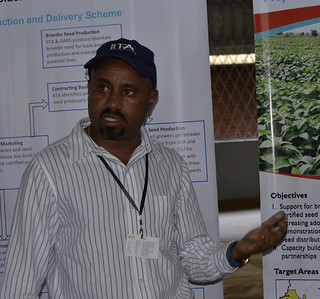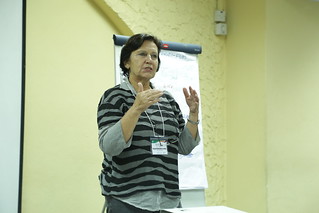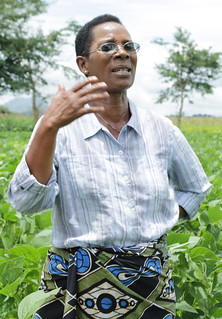Partners map out transition plans for Africa RISING-led Malawi INVC Bridging Activity Project
[youtube https://www.youtube.com/watch?v=NtOIsEeAxV8&w=560&h=315]
The Integrating Nutrition in Value Chains Bridging Activity (INVC BA) project was launched in June 2016 as a two-year relay project between INVC 1 and its successor project, Agricultural Diversification for Incomes and Nutrition (ADIN).
Funded by the United States Agency for International Development (USAID) Malawi Country Mission, the 2016/2017 cropping season was the first one under the INVC BA project. Partners implemented activities aimed at providing continuity to a subset of smallholder farmer groups and Extension Planning Areas (EPAs) that were supported under INVC 1.
On 29–30 June 2017, project partners met in Lilongwe to review progress of project implementation and discuss transition from the Bridging Activity to ADIN. The 2017/2018 cropping season will be the last one under the Bridging Activity.
Highlight achievements presented by partners for 2016/2017 were:
- Both groundnut and soya farmers had a good productive season.
- There was high technology uptake – particularly of the double row planting.
- Number of female farmers participating in the project was impressive.
Points of concern/ areas that need improvement:
- Reduction of soya seed value by 70%!
- All soya farmers expect losses this season (2016/2017) after harvest.
- Repayment is too high for the Chithumba model.
- The seed revolving system still unclear to most farmers. Is the project using 1:2 model or 1:4?
Partners had very engaging and transparent discussions about transition to the ADIN project. Key points raised were:
What should continue in the ADIN project from INVC BA activity?
- Promotion of the new technologies.
- Chithumba value for value (based on prevailing situation).
- Use of lead farmers. However, they need to be backed up by project staff.
- Involvement of District Agriculture Development Officers (DADO) in the promotions.
- Marketing promotion and also work to strengthen the system.
- Keep working through farmer organizations (association and cooperatives).
A briefing note to ADIN—practical implementation issues/realities of working with the communities.
- Try as much as possible to continue with performing partners from INVC BA.
- Continue with strengthening the marketing, many farmers still complain significantly about lack of markets.
- Continue sensitizing farmers about their Agricultural Commodity Exchange for Africa (ACE) products.
Best case scenario—what needs to happen in the transition from INVC BA to ADIN?
- Should continue with improved technologies.
- Continue with collaborative efforts with government.
- ADIN should pay attention to what did not work so well with the INVC BA and why.
- Aggregation and market linkages should continue.
- Collaboration with donors should continue.
Key quotes from the meeting
 ‘The name bridging in the title of the INVC BA project means the project itself is a bridge to another important one. It therefore implies building up from one stage to another—from INVC 1 to INVC BA and now to ADIN.’ — Alene Arega, International Institute of Tropical Agriculture (IITA) Malawi Country Representative.
‘The name bridging in the title of the INVC BA project means the project itself is a bridge to another important one. It therefore implies building up from one stage to another—from INVC 1 to INVC BA and now to ADIN.’ — Alene Arega, International Institute of Tropical Agriculture (IITA) Malawi Country Representative.
 ‘In the course of implementing the INVC Bridging Activity, IITA has remained a listening partner. At USAID, we are grateful for this relationship and the way the Bridging Activity has proceeded.’— Martin Banda, agriculture program development specialist, USAID
‘In the course of implementing the INVC Bridging Activity, IITA has remained a listening partner. At USAID, we are grateful for this relationship and the way the Bridging Activity has proceeded.’— Martin Banda, agriculture program development specialist, USAID
 ‘I thank all of you (partners) for the past 12 months of good collaboration and engagement, and I’m looking forward to this continuing in the next year! I also would want to thank Martin Banda for taking time to be with us at all stages of this meeting, but also in the course of implementing the project. This has helped us to achieve what the donor (USAID) expects from us. We are also grateful to colleagues from ADIN who joined and engaged with us. Wishing you all safe travels back home, thank you very much! — Irmgard Hoeschle-Zeledon, manager Africa RISING East/Southern Africa and West Africa Projects
‘I thank all of you (partners) for the past 12 months of good collaboration and engagement, and I’m looking forward to this continuing in the next year! I also would want to thank Martin Banda for taking time to be with us at all stages of this meeting, but also in the course of implementing the project. This has helped us to achieve what the donor (USAID) expects from us. We are also grateful to colleagues from ADIN who joined and engaged with us. Wishing you all safe travels back home, thank you very much! — Irmgard Hoeschle-Zeledon, manager Africa RISING East/Southern Africa and West Africa Projects
 ‘So far there has been great collaboration between ADIN and the INVC Bridging Activity. I am confident that this will continue even into this last cropping season as we transition between the two projects.’— Carl Larkins, chief of party Agricultural Diversification of Incomes and Nutrition
‘So far there has been great collaboration between ADIN and the INVC Bridging Activity. I am confident that this will continue even into this last cropping season as we transition between the two projects.’— Carl Larkins, chief of party Agricultural Diversification of Incomes and Nutrition
 ‘As way forward, we now expect to sit with the partners and the other projects with whom we are co-financing some of the activities like ADIN and Strengthening Agricultural and Nutrition Extension Services (SANE) to see how much funds are available. Each partner will then be advised accordingly about the funds available for their activities this year. Also, as part of project reporting, we will prepare an annual report of our activities and share with USAID. So, I am counting on you to submit the reports of some of the great works you shared in this meeting. Between now and the time the new contracts are finalized, I would also request that we already start identifying the new groups of farmers that we expect to work with. I think overall, we have been a good team and have achieved a lot in year one!’—Elizabeth Sibale, manager INVC Bridging Activity
‘As way forward, we now expect to sit with the partners and the other projects with whom we are co-financing some of the activities like ADIN and Strengthening Agricultural and Nutrition Extension Services (SANE) to see how much funds are available. Each partner will then be advised accordingly about the funds available for their activities this year. Also, as part of project reporting, we will prepare an annual report of our activities and share with USAID. So, I am counting on you to submit the reports of some of the great works you shared in this meeting. Between now and the time the new contracts are finalized, I would also request that we already start identifying the new groups of farmers that we expect to work with. I think overall, we have been a good team and have achieved a lot in year one!’—Elizabeth Sibale, manager INVC Bridging Activity
Read all the meeting notes
See pictures of the meeting




